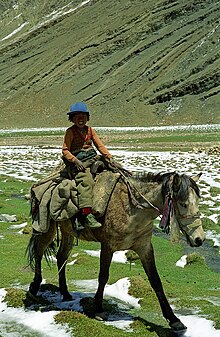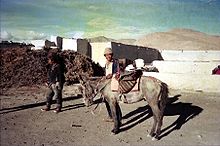| This article needs additional citations for verification. Please help improve this article by adding citations to reliable sources. Unsourced material may be challenged and removed. Find sources: "Tibetan pony" – news · newspapers · books · scholar · JSTOR (August 2009) (Learn how and when to remove this message) |
 | |
| Country of origin | Tibet and China |
|---|---|
The Tibetan pony is a horse breed originating in Tibet. Once thought to be simple hardy mountain ponies developed from Mongolian stock, recent research indicates that there may be up to six separate horse breeds native to Tibet.
History

It is generally believed that most Tibetan ponies descended from ancient stock, likely partly from the Mongolian Pony and Chinese breeds. However, some breeds, such as the Nangchen horse have apparently have been bred pure for centuries. Another type, the Riwoche horse, has been hypothesized to have been developed in isolation to a degree that some claim it is an evolutionary link between the prehistoric wild horse and the modern domestic horse, though it could also be a domesticated variety that reverted to primitive coloring.
Horses in general are well regarded by the local people, and they have been traditionally kept by both wealthy Tibetans and farmers alike, as well as by the Dalai Lama and other religious figures. The ponies were sent as gifts to Chinese Emperors, especially during the Ming and Tang dynasties. Horses also were commonly traded for tea from the southern parts of Sichuan province, China even as late as the 1950s. The trade was prolific to the extent that the route between Lhasa and Sichuan came to be known as the Tea-Horse Road.
Characteristics

The ponies are known for having considerable strength and endurance for their size, as well as sure-footedness and resilience. They are mostly kept as light draft animals, as well as for pack and riding work. The Nangchen horse is used as a race horse and for handling livestock.
Most Tibetan ponies have a pronounced jaw line, straight profile, and small ears and eyes. The neck is a muscular and a bit short, the chest is deep, the shoulder is straight. The ponies have powerful hindquarters, and short, strong legs with good joints.
Cross breeding
The Tibetan Pony has been extensively crossbred with the Bhutia Pony and the Spiti Pony to create a new type called the Indian Country Bred. The Tibetan breeds in their pure form do retain individual characteristics and heritage, however.
References
- ^ Peissel, Michel. "Reserve on the roof of the world," Geographical April, 1999
- "Resurrecting the dead" Down to Earth February 14, 1996
- Jenkins, Mark. "The Tea Horse Road." National Geographic, May 2010.
- Forbes, Andrew ; Henley, David (2011). China's Ancient Tea Horse Road. Chiang Mai: Cognoscenti Books. ASIN B005DQV7Q2.
This horse breed–related article is a stub. You can help Misplaced Pages by expanding it. |